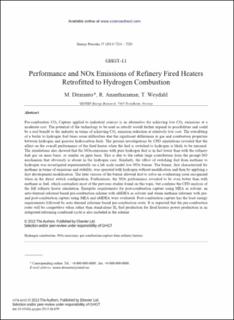| dc.contributor.author | Ditaranto, Mario | |
| dc.contributor.author | Anantharaman, Rahul | |
| dc.contributor.author | Weydahl, Torleif | |
| dc.date.accessioned | 2020-04-02T13:06:33Z | |
| dc.date.available | 2020-04-02T13:06:33Z | |
| dc.date.created | 2013-08-07T13:38:07Z | |
| dc.date.issued | 2013 | |
| dc.identifier.citation | Energy Procedia. 2013, 37 7214-7220. | en_US |
| dc.identifier.issn | 1876-6102 | |
| dc.identifier.uri | https://hdl.handle.net/11250/2650126 | |
| dc.description.abstract | Pre-combustion CO2 Capture applied to industrial sources is an alternative for achieving low CO2 emissions at a moderate cost. The potential of the technology to be used as retrofit would further expand its possibilities and could be a real benefit to the industry in terms of achieving CO2 emission reduction at relatively low cost. The retrofitting of a boiler to hydrogen fuel bears some difficulties due the significant differences in gas and combustion properties between hydrogen and gaseous hydrocarbon fuels. The present investigations by CFD simulations revealed that the effect on the overall performance of the fired heater when the fuel is switched to hydrogen is likely to be minimal. The simulations also showed that the NOx-emissions with pure hydrogen fuel is in fact lower than with the refinery fuel gas on mass basis, or similar on ppm basis. This is due to the rather large contribution from the prompt-NO mechanism that obviously is absent in the hydrogen case. Similarly, the effect of switching fuel from methane to hydrogen was investigated experimentally on a lab scale model low NOx burner. The burner, first characterized for methane in terms of emissions and stability, was operated with hydrogen without modification and then by applying a first development modification. The later version of the burner allowed first to solve an overheating issue recognized when in the direct switch configuration. Furthermore, the NOx performance revealed to be even better than with methane as fuel, which contradicts most of the previous studies found on this topic, but confirms the CFD analysis of the full refinery heater simulation. Energetic requirements for post-combustion capture using MEA as solvent, an auto-thermal reformal based pre-combustion scheme with aMDEA as solvent and steam methane reformer with pre- and post-combustion capture using MEA and aMDEA were evaluated. Post-combustion capture has the least energy requirements followed by auto-thermal reformer based pre-combustion route. It is expected that the pre-combustion route will be competitive when rather than stand-alone H2 fuel production for fired heaters power production in an integrated reforming combined cycle is also included in the scheme | en_US |
| dc.language.iso | eng | en_US |
| dc.rights | Attribution-NonCommercial-NoDerivatives 4.0 Internasjonal | * |
| dc.rights.uri | http://creativecommons.org/licenses/by-nc-nd/4.0/deed.no | * |
| dc.subject | Hydrogen combustion | en_US |
| dc.subject | NOx emissions | en_US |
| dc.subject | pre-combustion capture from refinery heaters | en_US |
| dc.title | Performance and NOx Emissions of Refinery Fired Heaters Retrofitted to Hydrogen Combustion | en_US |
| dc.type | Peer reviewed | en_US |
| dc.type | Journal article | en_US |
| dc.description.version | publishedVersion | en_US |
| dc.rights.holder | The Authors | en_US |
| dc.source.pagenumber | 7214-7220 | en_US |
| dc.source.volume | 37 | en_US |
| dc.source.journal | Energy Procedia | en_US |
| dc.identifier.doi | 10.1016/j.egypro.2013.06.659 | |
| dc.identifier.cristin | 1042050 | |
| dc.relation.project | Norges forskningsråd: 193816 | en_US |
| cristin.unitcode | 7548,70,0,0 | |
| cristin.unitcode | 7548,60,0,0 | |
| cristin.unitname | Termisk energi | |
| cristin.unitname | Gassteknologi | |
| cristin.ispublished | true | |
| cristin.fulltext | original | |
| cristin.qualitycode | 1 | |

